Inhibition of Citric Acid-Induced Dentin Erosion by an Acidulated Phosphate Sodium Monofluorophosphate Solution
Abstract
:1. Introduction
2. Materials and Methods
2.1. Preparation of Dentin Samples
2.2. Fluoride Application and pH-Cycling Acid Challenge
2.3. Three-Dimensional Laser Microscopy
2.4. Vickers Hardness Measurement
2.5. Cross-Sectional Morphology Assessment Using Scanning Electron Microscopy (SEM)
2.6. Contact Microradiography (CMR)
2.7. Statistical Analysis
3. Results
3.1. Step Height Profiles after pH Cycling
3.2. Calculated Average Roughness after pH Cycling
3.3. Vickers Hardness and Changes after pH Cycling
3.4. Dentin Surface SEM Observations after pH Cycling
3.5. Cross-Sectional SEM Imaging after pH Cycling
3.6. Measurement of Mineral Loss and Lesion Depths Using CMR Analysis
4. Discussion
4.1. Resistance of Dentin to Citric Acid after AP-MFP Treatment
4.2. Dentin Acid Resistance Mechanism of AP-MFP
4.3. Limitations of Research Methods and Prospects for Clinical Dentistry
5. Conclusions
Author Contributions
Funding
Institutional Review Board Statement
Informed Consent Statement
Data Availability Statement
Acknowledgments
Conflicts of Interest
References
- Lussi, A.; Jaeggi, T. Erosion—Diagnosis and risk factors. Clin. Oral Investig. 2008, 12 (Suppl. S1), 5–13. [Google Scholar] [CrossRef] [PubMed] [Green Version]
- Lussi, A.; Carvalho, T.S. Erosive tooth wear: A multifactorial condition of growing concern and increasing knowledge. Erosive Tooth Wear. 2014, 25, 1–15. [Google Scholar] [CrossRef]
- Eguchi, T.; Satou, R.; Miake, Y.; Sugihara, N. Comparison of resistance of dentin to erosive acid after application of fluoride to teeth. J. Hard Tissue Biol. 2020, 29, 193–202. [Google Scholar] [CrossRef]
- Wierichs, R.J.; Meyer-Lueckel, H. Systematic review on noninvasive treatment of root caries lesions. J. Dent. Res. 2015, 94, 261–271. [Google Scholar] [CrossRef] [PubMed]
- Lussi, A.; Carvalho, T.S. The future of fluorides and other protective agents in erosion prevention. Caries Res. 2015, 49 (Suppl. S1), 18–29. [Google Scholar] [CrossRef] [PubMed] [Green Version]
- Ludovichetti, F.S.; Signoriello, A.G.; Colussi, N.; Zuccon, A.; Stellini, E.; Mazzoleni, S. Soft drinks and dental erosion during pediatric age: A clinical investigation. Minerva Dent. Oral Sci. 2022, 71, 262–269. [Google Scholar] [CrossRef]
- Mazzoleni, S.; Gargani, A.; Parcianello, R.G.; Pezzato, L.; Bertolini, R.; Zuccon, A.; Stellini, E.; Ludovichetti, F.S. Protection against dental erosion and the remineralization capacity of non-fluoride toothpaste, fluoride toothpaste and fluoride varnish. Appl. Sci. 2023, 13, 1849. [Google Scholar] [CrossRef]
- Walsh, T.; Worthington, H.V.; Glenny, A.M.; Marinho, V.C.; Jeroncic, A. Fluoride toothpastes of different concen trations for preventing dental caries. Cochrane Database Syst. Rev. 2019, 3, CD007868. [Google Scholar] [CrossRef]
- Volpe, A.R.; Petrone, M.E.; Davies, R.; Proskin, H.M. Clinical anticaries efficacy of NaF and SMFP dentifrices: Overview and resolution of the scientific controversy. J. Clin. Dent. 1995, 6, 1–28. [Google Scholar]
- Ten Cate, J.M.; Rempt, H.E. Comparison of the in vivo effect of a 0 and 1,500 ppmF MFP toothpaste on fluoride uptake, acid resistance and lesion remineralization. Caries Res. 1986, 20, 193–201. [Google Scholar] [CrossRef]
- Shourie, K.L.; Hein, J.W.; Carpenter Hodge, H. Preliminary studies of the caries inhibiting potential and acute tox icity of sodium monofluorophosphate. J. Dent. Res. 1950, 29, 529–533. [Google Scholar] [CrossRef] [PubMed]
- White, W.E. Monofluorophosphate—Its beginning. Caries Res. 1983, 17 (Suppl. S1), 2–8. [Google Scholar] [CrossRef] [PubMed]
- Tanizawa, Y.; Tsuchikane, H.; Sawamura, K.; Suzuki, T. Reaction characteristics of hydroxyapatite with F- and PO3F2- ions. Chemical states of fluorine in hydroxyapatite. J. Chem. Soc. Faraday Trans. 1991, 87, 2235–2240. [Google Scholar] [CrossRef]
- Atsushi, Y.; Kazuo, K.; Haruo, N. Differences in effects of sodium fluoride and sodium monofluorophosphate on acid resistance of enamel. J. Dent. Health 2007, 57, 13–21. [Google Scholar] [CrossRef]
- Ingram, G.S. The reaction of monofluorophosphate with apatite. Caries Res. 1972, 6, 1–15. [Google Scholar] [CrossRef]
- Eanes, E.D. The reaction of monofluorophosphate with amorphous and apatitic calcium phosphates. Caries Res. 1976, 10, 59–71. [Google Scholar] [CrossRef]
- Sugai, M.; Matsuda, Y.; Nagayama, M.; Kaga, M.; Yawaka, Y. Comparison of enamel demineralization between deciduous and permanent teeth using the automatic PH-cycling system. Jpn. J. Pediatr. Dent. 2010, 48, 48–55. [Google Scholar] [CrossRef]
- Matsuda, Y.; Murata, Y.; Tanaka, T.; Komatsu, H.; Sano, H. Development of new software as a convenient analy sis method for dental microradiography. Dent. Mater. J. 2007, 26, 414–421. [Google Scholar] [CrossRef] [Green Version]
- Matsuda, Y.; Komatsu, H.; Murata, Y.; Tanaka, T.; Sano, H. A newly designed automatic PH-cycling system to simulate daily PH fluctuations. Dent. Mater. J. 2006, 25, 280–285. [Google Scholar] [CrossRef] [Green Version]
- Satou, R.; Iwasaki, M.; Kamijo, H.; Sugihara, N. Improved enamel acid resistance using biocompatible nano-hy droxyapatite coating method. Materials 2022, 15, 7171. [Google Scholar] [CrossRef]
- Angmar, B.; Carlström, D.; Glas, J.E. Studies on the ultrastructure of dental enamel: IV. The mineralization of normal human enamel. J. Ultrastruct. Res. 1963, 8, 12–23. [Google Scholar] [CrossRef]
- Pinto, S.C.S.; Bandéca, M.C.; Pinheiro, M.C.; Cavassim, R.; Tonetto, M.R.; Borges, A.H.; Sampaio, J.E.C. Pre ventive effect of a high fluoride toothpaste and arginine-carbonate toothpaste on dentinal tubules exposure followed by acid challenge: A dentine permeability evaluation. BMC Res. Notes 2014, 7, 385. [Google Scholar] [CrossRef] [Green Version]
- Satou, R.; Yamagishi, A.; Takayanagi, A.; Iwasaki, M.; Kamijo, H.; Sugihara, N. Improved enamel acid resistance by highly concentrated acidulated phosphate sodium monofluorophosphate solution. Materials 2022, 15, 7298. [Google Scholar] [CrossRef]
- Lynch, E.; Baysan, A. Reversal of primary root caries using a dentifrice with a high fluoride content. Caries Res. 2001, 35 (Suppl. S1), 60–64. [Google Scholar] [CrossRef]
- Ten Cate, J.M.; Duijsters, P.P.E. Influence of fluoride in solution on tooth demineralization. I. Chemical data. Caries Res. 1983, 17, 193–199. [Google Scholar] [CrossRef]
- Ten Cate, J.M.; Duijsters, P.P.E. Influence of fluoride in solution on tooth demineralization. II. Microradiograph ical data. Caries Res. 1983, 17, 513–519. [Google Scholar] [CrossRef] [PubMed]
- Wiegand, A.; Buchalla, W.; Attin, T. Review on fluoride-releasing restorative materials—Fluoride release and up take characteristics, antibacterial activity and influence on caries formation. Dent. Mater. 2007, 23, 343–362. [Google Scholar] [CrossRef]
- Mellberg, J.R. Monofluorophosphate utilization in oral preparations: Laboratory observations. Caries Res. 1983, 17 (Suppl. S1), 102–118. [Google Scholar] [CrossRef] [PubMed]
- Featherstone, J.D. Consensus conference on intra-oral models: Evaluation techniques. J. Dent. Res. 1992, 71, 955–956. [Google Scholar] [CrossRef] [PubMed]
- Nishida, A.; Kani, M.; Ikuta, S.; Yokoi, K.; Isozaki, A.; Kani, T. A study on topical application. J. Dent. Health 1994, 44, 277–285. [Google Scholar] [CrossRef]
- Bruun, C.; Givskov, H. Formation of CaF2 on sound enamel and in caries-like enamel lesions after different forms of fluoride applications in vitro. Caries Res. 1991, 25, 96–100. [Google Scholar] [CrossRef]
- Joyston-Bechal, S.; Duckworth, R.; Braden, M. The mechanism of uptake of 18F by enamel from sodium fluoride and acidulated phosphate fluoride solutions labelled with 18F. Arch. Oral Biol. 1973, 18, 1077–1089. [Google Scholar] [CrossRef]
- Ogaard, B.; Rölla, G.; Helgeland, K. Alkali soluble and alkali insoluble fluoride retention in demineralized enamel in vivo. Scand. Eur. J. Oral Sci. 1983, 91, 200–204. [Google Scholar] [CrossRef]
- Ogaard, B.; Rölla, G.; Helgeland, K. Uptake and retention of alkali-soluble and alkali-insoluble fluoride in sound enamel in vivo after mouthrinses with 0.05% or 0.2% NaF. Caries Res. 1983, 17, 520–524. [Google Scholar] [CrossRef]
- Chow, L.C.; Brown, W.E. Formation of CaHPO4·2H2O in tooth enamel as an intermediate product in topical fluoride treatments. J. Dent. Res. 1975, 54, 65–76. [Google Scholar] [CrossRef]
- Grøn, P.; Brudevold, F.; Aasenden, R. Monofluorophosphate interaction with hydroxyapatite and intact enamel. Caries Res. 1971, 5, 202–214. [Google Scholar] [CrossRef]
- Bruun, C.; Givskov, H.; Thylstrup, A. Whole saliva fluoride after toothbrushing with NaF and MFP dentifrices with different F concentrations. Caries Res. 1984, 18, 282–288. [Google Scholar] [CrossRef] [PubMed]
- Mellberg, J.R.; Mallon, D.E. Acceleration of remineralization in vitro by sodium monofluorophosphate and so dium fluoride. J. Dent. Res. 1984, 63, 1130–1135. [Google Scholar] [CrossRef]
- Mellberg, J.R.; Chomicki, W.G.; Mallon, D.E.; Castrovince, L.A. Remineralization in vivo of artificial caries le sions by a monofluorophosphate dentifrice. Caries Res. 1985, 19, 126–135. [Google Scholar] [CrossRef] [PubMed]
- Ruehrwein, R.A.; Ward, D.W. Mechanism of clay aggregation by polyelectrolytes. Soil Sci. 1952, 73, 485–492. [Google Scholar] [CrossRef]
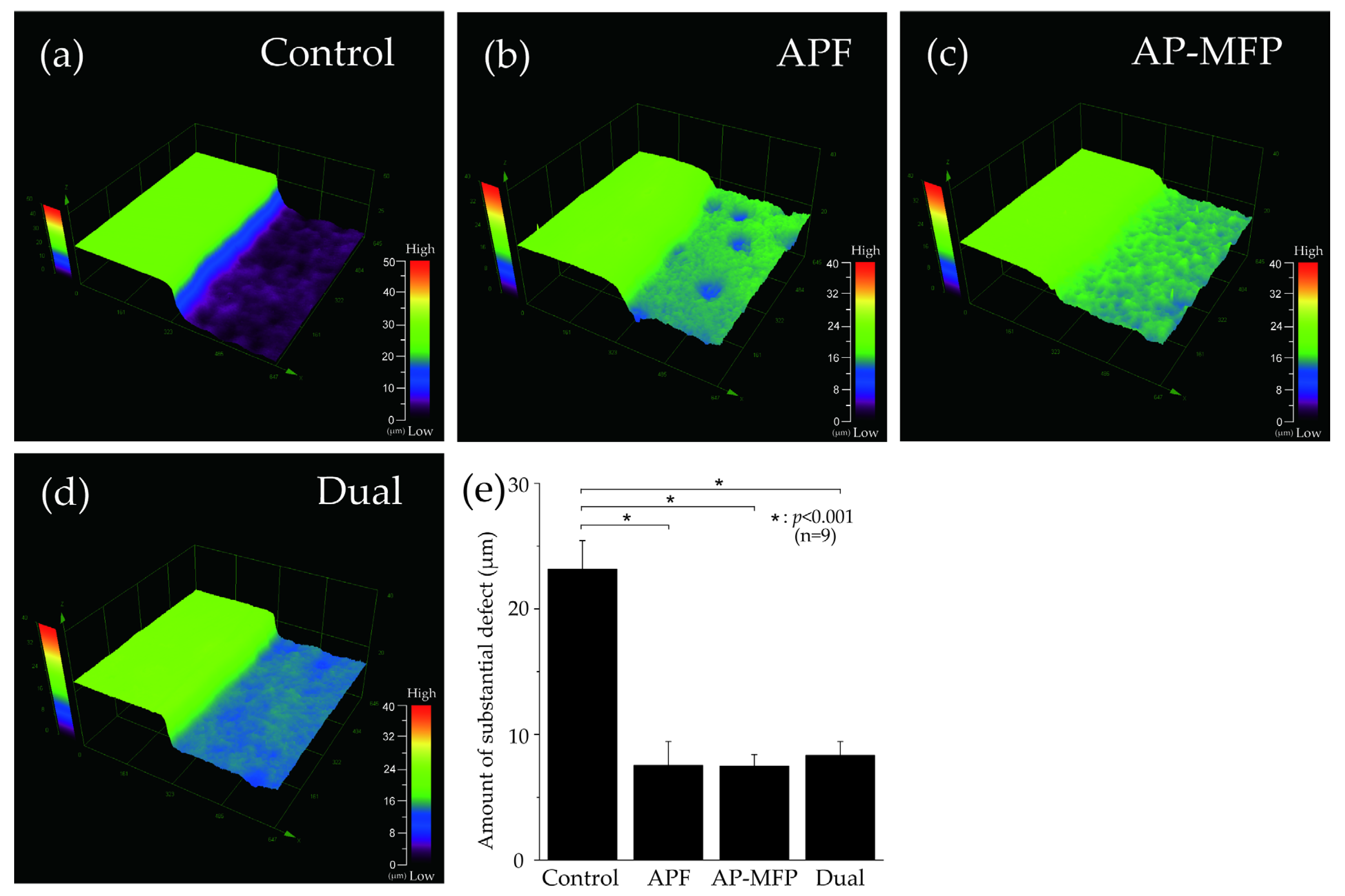
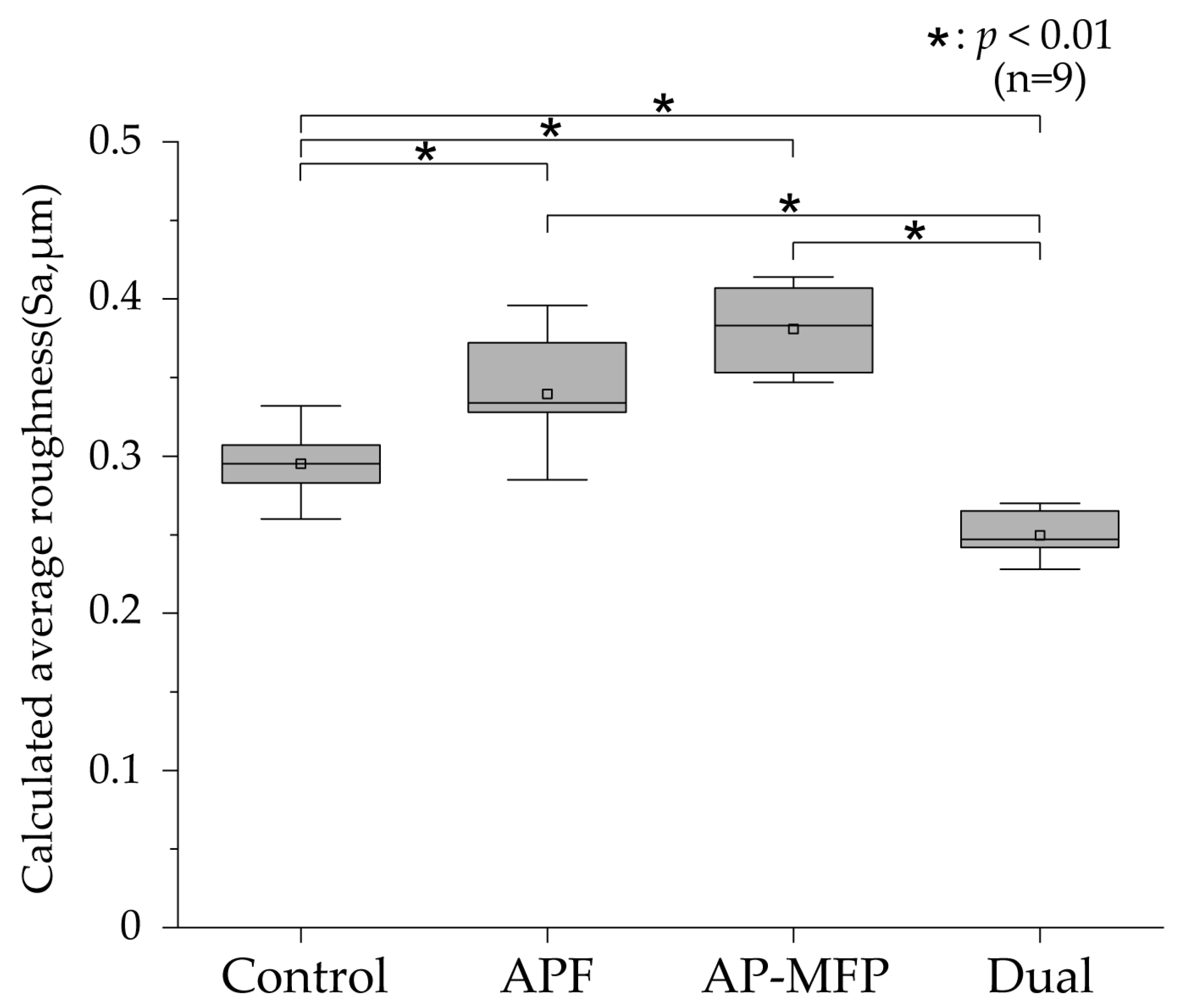

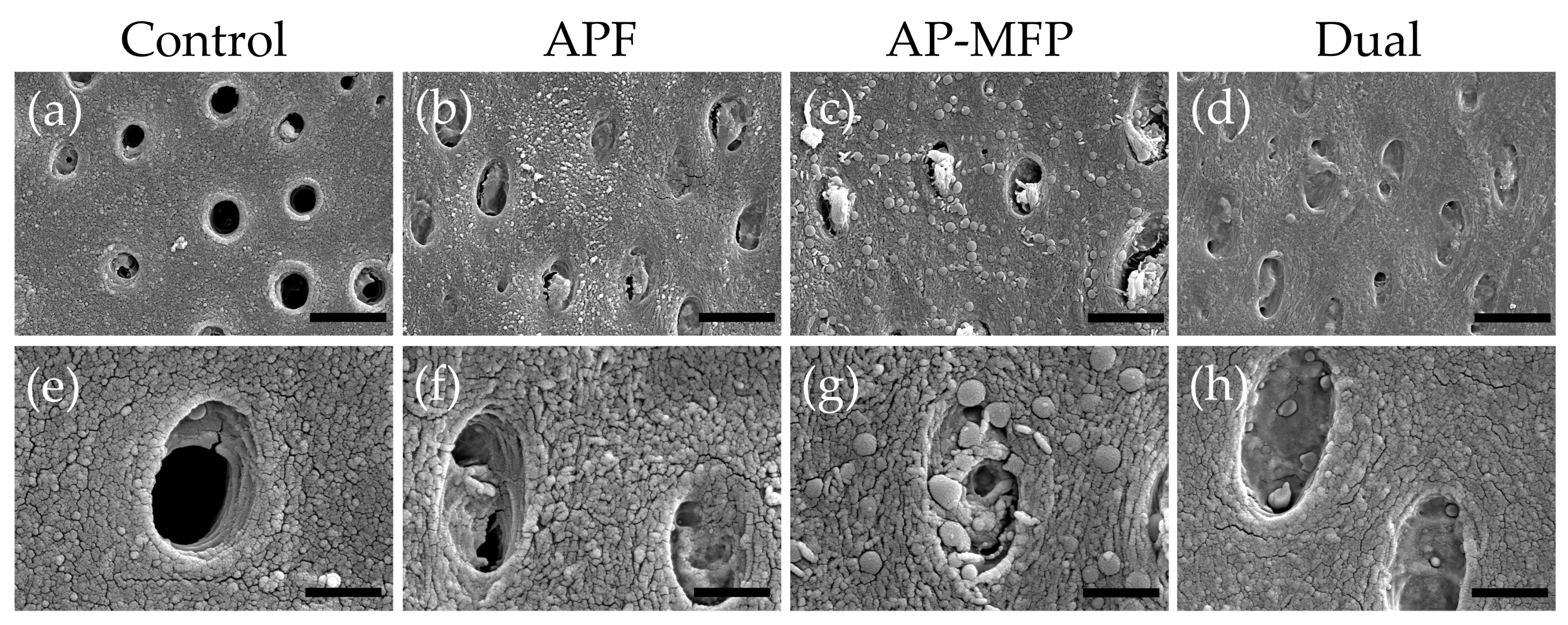

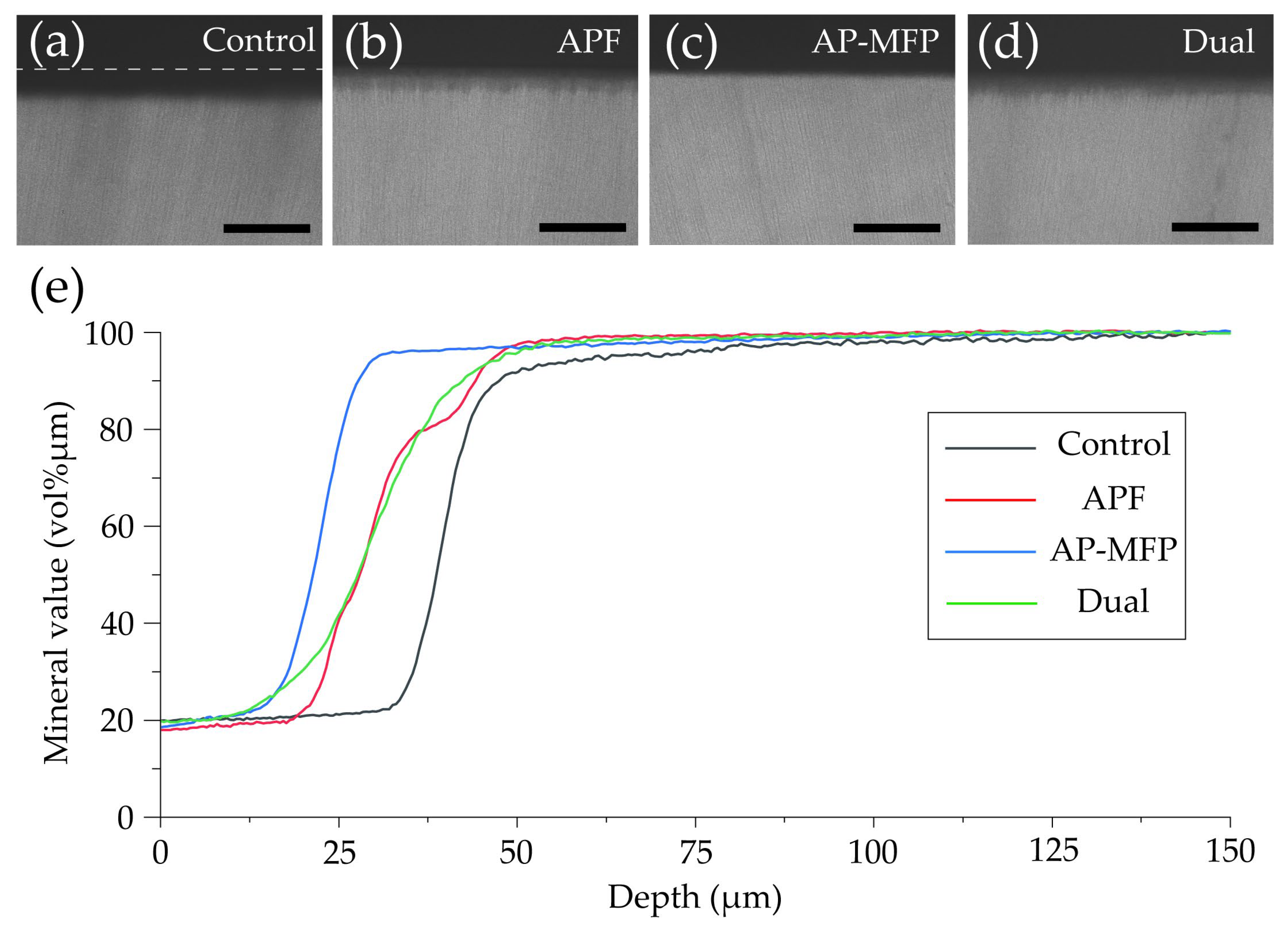
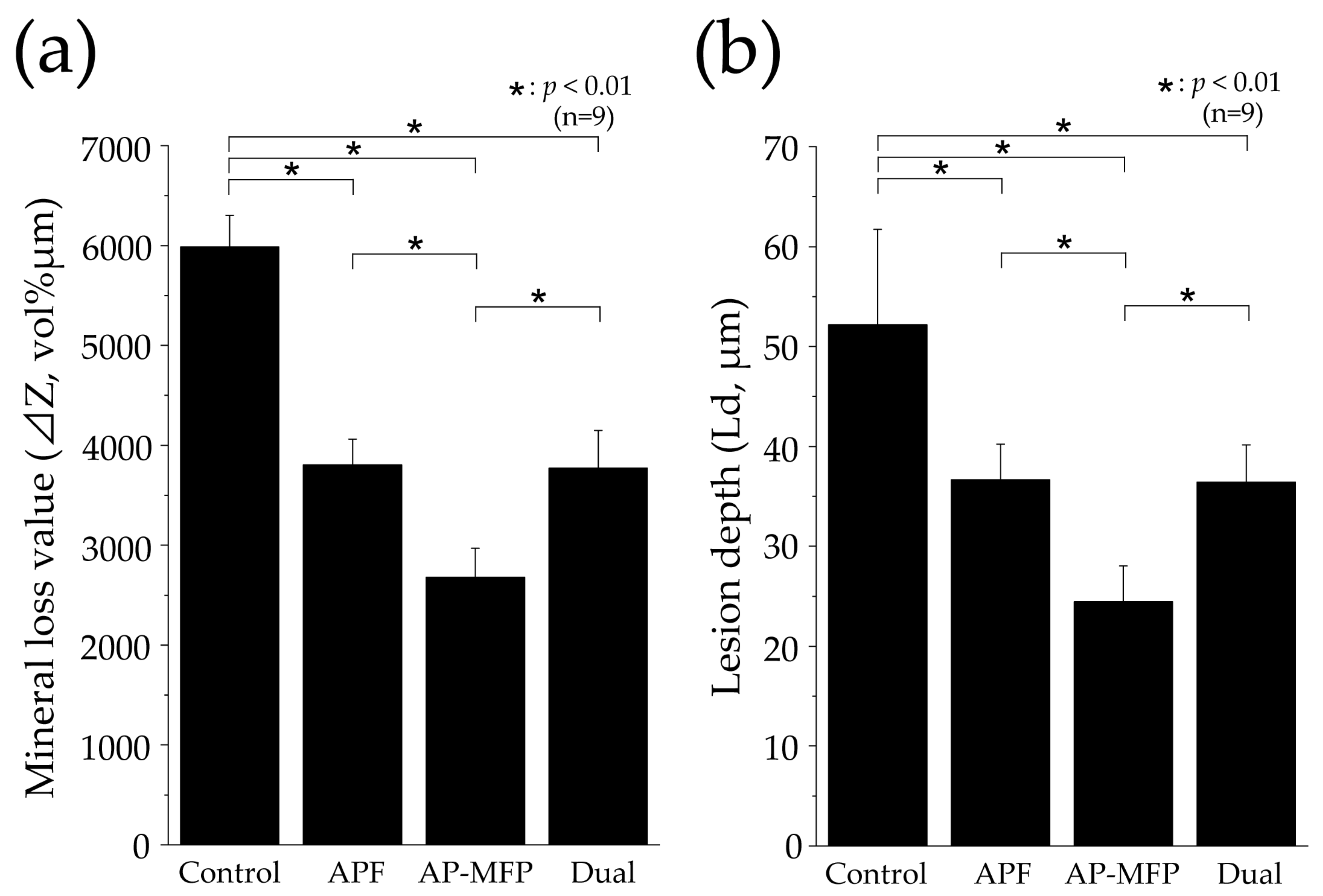
Disclaimer/Publisher’s Note: The statements, opinions and data contained in all publications are solely those of the individual author(s) and contributor(s) and not of MDPI and/or the editor(s). MDPI and/or the editor(s) disclaim responsibility for any injury to people or property resulting from any ideas, methods, instructions or products referred to in the content. |
© 2023 by the authors. Licensee MDPI, Basel, Switzerland. This article is an open access article distributed under the terms and conditions of the Creative Commons Attribution (CC BY) license (https://creativecommons.org/licenses/by/4.0/).
Share and Cite
Satou, R.; Ueno, S.; Kamijo, H.; Sugihara, N. Inhibition of Citric Acid-Induced Dentin Erosion by an Acidulated Phosphate Sodium Monofluorophosphate Solution. Materials 2023, 16, 5230. https://doi.org/10.3390/ma16155230
Satou R, Ueno S, Kamijo H, Sugihara N. Inhibition of Citric Acid-Induced Dentin Erosion by an Acidulated Phosphate Sodium Monofluorophosphate Solution. Materials. 2023; 16(15):5230. https://doi.org/10.3390/ma16155230
Chicago/Turabian StyleSatou, Ryouichi, Susumu Ueno, Hideyuki Kamijo, and Naoki Sugihara. 2023. "Inhibition of Citric Acid-Induced Dentin Erosion by an Acidulated Phosphate Sodium Monofluorophosphate Solution" Materials 16, no. 15: 5230. https://doi.org/10.3390/ma16155230






